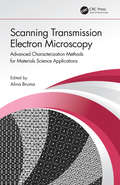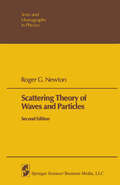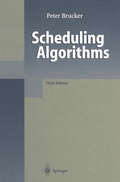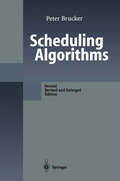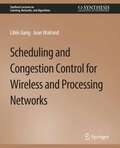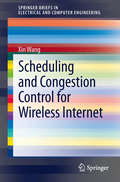- Table View
- List View
Scanning Technologies for Autonomous Systems
by Oleg Sergiyenko Wendy Flores-Fuentes Julio C. Rodríguez-Quiñonez Moises J. Castro-ToscanoThis book provides the theory, methodology, and uses of scanning technologies for the application of autonomous systems. The authors provide readers with an understanding of different technologies and methods to perform scanning technologies and their optimal application depending on the kind of autonomous system. Also, the book presents a compilation of original high-quality contributions and research results from worldwide authors on emerging new autonomous systems based on different scanning technologies. This book is a valuable reference for engineering professionals and the scientific community.
Scanning Transmission Electron Microscopy: Advanced Characterization Methods for Materials Science Applications
by Alina BrumaScanning Transmission Electron Microscopy is focused on discussing the latest approaches in the recording of high-fidelity quantitative annular dark-field (ADF) data. It showcases the application of machine learning in electron microscopy and the latest advancements in image processing and data interpretation for materials notoriously difficult to analyze using scanning transmission electron microscopy (STEM). It also highlights strategies to record and interpret large electron diffraction datasets for the analysis of nanostructures. This book: Discusses existing approaches for experimental design in the recording of high-fidelity quantitative ADF data Presents the most common types of scintillator-photomultiplier ADF detectors, along with their strengths and weaknesses. Proposes strategies to minimize the introduction of errors from these detectors and avenues for dealing with residual errors Discusses the practice of reliable multiframe imaging, along with the benefits and new experimental opportunities it presents in electron dose or dose-rate management Focuses on supervised and unsupervised machine learning for electron microscopy Discusses open data formats, community-driven software, and data repositories Proposes methods to process information at both global and local scales, and discusses avenues to improve the storage, transfer, analysis, and interpretation of multidimensional datasets Provides the spectrum of possibilities to study materials at the resolution limit by means of new developments in instrumentation Recommends methods for quantitative structural characterization of sensitive nanomaterials using electron diffraction techniques and describes strategies to collect electron diffraction patterns for such materials This book helps academics, researchers, and industry professionals in materials science, chemistry, physics, and related fields to understand and apply computer-science–derived analysis methods to solve problems regarding data analysis and interpretation of materials properties.
Scanning Transmission Electron Microscopy: Advanced Characterization Methods for Materials Science Applications
by Alina BrumaScanning Transmission Electron Microscopy is focused on discussing the latest approaches in the recording of high-fidelity quantitative annular dark-field (ADF) data. It showcases the application of machine learning in electron microscopy and the latest advancements in image processing and data interpretation for materials notoriously difficult to analyze using scanning transmission electron microscopy (STEM). It also highlights strategies to record and interpret large electron diffraction datasets for the analysis of nanostructures. This book: Discusses existing approaches for experimental design in the recording of high-fidelity quantitative ADF data Presents the most common types of scintillator-photomultiplier ADF detectors, along with their strengths and weaknesses. Proposes strategies to minimize the introduction of errors from these detectors and avenues for dealing with residual errors Discusses the practice of reliable multiframe imaging, along with the benefits and new experimental opportunities it presents in electron dose or dose-rate management Focuses on supervised and unsupervised machine learning for electron microscopy Discusses open data formats, community-driven software, and data repositories Proposes methods to process information at both global and local scales, and discusses avenues to improve the storage, transfer, analysis, and interpretation of multidimensional datasets Provides the spectrum of possibilities to study materials at the resolution limit by means of new developments in instrumentation Recommends methods for quantitative structural characterization of sensitive nanomaterials using electron diffraction techniques and describes strategies to collect electron diffraction patterns for such materials This book helps academics, researchers, and industry professionals in materials science, chemistry, physics, and related fields to understand and apply computer-science–derived analysis methods to solve problems regarding data analysis and interpretation of materials properties.
Scare Tactics: Arguments that Appeal to Fear and Threats (Argumentation Library #3)
by Douglas WaltonScare Tactics, the first book on the subject, provides a theory of the structure of reasoning used in fear and threat appeal argumentation. Such arguments come under the heading of the argumentum ad baculum, the `argument to the stick/club', traditionally treated as a fallacy in the logic textbooks. The new dialectical theory is based on case studies of many interesting examples of the use of these arguments in advertising, public relations, politics, international negotiations, and everyday argumentation on all kinds of subjects. Many of these arguments are amusing, once you see the clever tactic used; others are scary. Some of the arguments appear to be quite reasonable, while others are highly suspicious, or even outrageously fraudulent. In addition to the examples taken from logic textbooks, other cases treated come from a variety of sources, including political debates, legal arguments, and arguments from media sources, like magazine articles and television ads. The purpose of this book is to explain how such arguments work as devices of persuasion, and to develop a method for analyzing and evaluating their reasonable and fallacious uses in particular cases. The book shows how such arguments share a common structure, revealing several distinctive forms of argument nested within each other. Based on its account of this cognitive structure, the new dialectical theory presents methods for identifying, analyzing, and evaluating these arguments, as they are used in specific cases. The book is a scholarly contribution to argumentation theory. It is written in an accessible style, and uses many colorful and provocative examples of fear and threat appeal arguments that are suitable for classroom discussions. The matters treated will be of interest to professionals and students in law, critical thinking, advertising, speech communication, informal logic, cognitive science, rhetoric, and media studies.
Scary Smart: The Future of Artificial Intelligence and How You Can Save Our World
by Mo GawdatTechnology is putting our humanity at risk to an unprecedented degree. This book is not for engineers who write the code or the policy makers who claim they can regulate it. This is a book for you. Because, believe it or not, you are the only one that can fix it. – Mo GawdatArtificial intelligence is smarter than humans. It can process information at lightning speed and remain focused on specific tasks without distraction. AI can see into the future, predicting outcomes and even use sensors to see around physical and virtual corners. So why does AI frequently get it so wrong?The answer is us. Humans design the algorithms that define the way that AI works, and the processed information reflects an imperfect world. Does that mean we are doomed? In Scary Smart, Mo Gawdat, the internationally bestselling author of Solve for Happy, draws on his considerable expertise to answer this question and to show what we can all do now to teach ourselves and our machines how to live better. With more than thirty years' experience working at the cutting-edge of technology and his former role as chief business officer of Google [X], no one is better placed than Mo Gawdat to explain how the Artificial Intelligence of the future works.By 2049 AI will be a billion times more intelligent than humans. Scary Smart explains how to fix the current trajectory now, to make sure that the AI of the future can preserve our species. This book offers a blueprint, pointing the way to what we can do to safeguard ourselves, those we love and the planet itself.
Scatter Search: Methodology and Implementations in C (Operations Research/Computer Science Interfaces Series #24)
by Manuel Laguna Rafael MartíThe book Scatter Search by Manuel Laguna and Rafael Martí represents a long-awaited "missing link" in the literature of evolutionary methods. Scatter Search (SS)-together with its generalized form called Path Relinking-constitutes the only evolutionary approach that embraces a collection of principles from Tabu Search (TS), an approach popularly regarded to be divorced from evolutionary procedures. The TS perspective, which is responsible for introducing adaptive memory strategies into the metaheuristic literature (at purposeful level beyond simple inheritance mechanisms), may at first seem to be at odds with population-based approaches. Yet this perspective equips SS with a remarkably effective foundation for solving a wide range of practical problems. The successes documented by Scatter Search come not so much from the adoption of adaptive memory in the range of ways proposed in Tabu Search (except where, as often happens, SS is advantageously coupled with TS), but from the use of strategic ideas initially proposed for exploiting adaptive memory, which blend harmoniously with the structure of Scatter Search. From a historical perspective, the dedicated use of heuristic strategies both to guide the process of combining solutions and to enhance the quality of offspring has been heralded as a key innovation in evolutionary methods, giving rise to what are sometimes called "hybrid" (or "memetic") evolutionary procedures. The underlying processes have been introduced into the mainstream of evolutionary methods (such as genetic algorithms, for example) by a series of gradual steps beginning in the late 1980s.
Scattering and Structures: Essentials and Analogies in Quantum Physics
by Bogdan Povh Mitja RosinaQuantum physics may appear complicated, especially if one forgets the "big picture" and gets lost in the details. However, it can become clearer and less tangled if one applies a few fundamental concepts so that simplified approaches can emerge and estimated orders of magnitude become clear. Povh and Rosina’s Scattering and Structures presents the properties of quantum systems (elementary particles, nucleons, atoms, molecules, quantum gases, quantum liquids, stars, and early universe) with the help of elementary concepts and analogies between these seemingly different systems. The original German-language edition of this book was written for students preparing for their final oral examination in physics. By and large, the scope of the book in English has been essentially enlarged and thus may also be of interest for physicists in general.
Scattering Theory of Waves and Particles (Theoretical and Mathematical Physics)
by R.G. NewtonMuch progress has been made in scattering theory since the publication of the first edition of this book fifteen years ago, and it is time to update it. Needless to say, it was impossible to incorporate all areas of new develop ment. Since among the newer books on scattering theory there are three excellent volumes that treat the subject from a much more abstract mathe matical point of view (Lax and Phillips on electromagnetic scattering, Amrein, Jauch and Sinha, and Reed and Simon on quantum scattering), I have refrained from adding material concerning the abundant new mathe matical results on time-dependent formulations of scattering theory. The only exception is Dollard's beautiful "scattering into cones" method that connects the physically intuitive and mathematically clean wave-packet description to experimentally accessible scattering rates in a much more satisfactory manner than the older procedure. Areas that have been substantially augmented are the analysis of the three-dimensional Schrodinger equation for non central potentials (in Chapter 10), the general approach to multiparticle reaction theory (in Chapter 16), the specific treatment of three-particle scattering (in Chapter 17), and inverse scattering (in Chapter 20). The additions to Chapter 16 include an introduction to the two-Hilbert space approach, as well as a derivation of general scattering-rate formulas. Chapter 17 now contains a survey of various approaches to the solution of three-particle problems, as well as a discussion of the Efimov effect.
Scenario-Based Training with X-Plane and Microsoft Flight Simulator: Using PC-Based Flight Simulations Based on FAA-Industry Training Standards
by Bruce WilliamsFly toward pilot certification with these real-world scenario exercises Although PC-based flight simulations have been available for 30 years, many pilots, instructors, and flight schools don't understand how best to use these tools in real-world flight training and pilot proficiency programs. This invaluable reference bridges the gap between simulation tools and real-world situations by presenting hands-on, scenario-based exercises and training tips for the private pilot certificate and instrument rating. As the first of its kind based on FAA-Industry Training Standards (FITS), this book steers its focus on a scenario-based curriculum that emphasizes real-world situations. Experienced pilot and author Bruce Williams ultimately aims to engage the pilot, reinforce the "realistic" selling point of PC-based flight simulations, while also complementing the FAA-approved FITS syllabi. Serves as essential reading for pilots who want to make effective use of simulation in their training while expanding their skill level and enjoyment of flying Covers private pilot real-world scenarios and instrument rating scenarios Includes a guide to recommended websites and other resources Features helpful charts as well as a glossary You'll take off towards pilot certification with this invaluable book by your side.
Scenario-Based Training with X-Plane and Microsoft Flight Simulator: Using PC-Based Flight Simulations Based on FAA-Industry Training Standards
by Bruce WilliamsFly toward pilot certification with these real-world scenario exercises Although PC-based flight simulations have been available for 30 years, many pilots, instructors, and flight schools don't understand how best to use these tools in real-world flight training and pilot proficiency programs. This invaluable reference bridges the gap between simulation tools and real-world situations by presenting hands-on, scenario-based exercises and training tips for the private pilot certificate and instrument rating. As the first of its kind based on FAA-Industry Training Standards (FITS), this book steers its focus on a scenario-based curriculum that emphasizes real-world situations. Experienced pilot and author Bruce Williams ultimately aims to engage the pilot, reinforce the "realistic" selling point of PC-based flight simulations, while also complementing the FAA-approved FITS syllabi. Serves as essential reading for pilots who want to make effective use of simulation in their training while expanding their skill level and enjoyment of flying Covers private pilot real-world scenarios and instrument rating scenarios Includes a guide to recommended websites and other resources Features helpful charts as well as a glossary You'll take off towards pilot certification with this invaluable book by your side.
Scenarios: International Workshop, Dagstuhl Castle, Germany, September 7-12, 2003, Revised Selected Papers (Lecture Notes in Computer Science #3466)
by Stefan Leue Tarja J. SystäVisual notations and languages continue to play a pivotal role ˆ in the design of complex software systems. In many cases visual notations are used to - scribe usage or interaction scenarios of software systems or their components. While representing scenarios using a visual notation is not the only possibility, a vast majority of scenario description languages is visual. Scenarios are used in telecommunications as Message Sequence Charts, in object-oriented system design as Sequence Diagrams, in reverse engineering as execution traces, and in requirements engineering as, for example, Use Case Maps or Life Sequence Charts. These techniques are used to capture requirements, to capture use cases in system documentation, to specify test cases, or to visualize runs of existing systems. They are often employed to represent concurrent systems that int- act via message passing or method invocation. In telecommunications, for more than 15 years the International Telecommunication Union has standardized the Message Sequence Charts (MSCs) notation in its recommendation Z. 120. More recently, with the emergence of UML as a predominant software design meth- ology, there has been special interest in the development of the sequence d- gram notation. As a result, the most recent version, 2. 0, of UML encompasses the Message Sequence Chart notation, including its hierarchical modeling f- tures. Other scenario-?avored diagrams in UML 2. 0 include activity diagrams and timing diagrams.
Scenarios, Stories, Use Cases: Through the Systems Development Life-Cycle
by Ian F. Alexander Neil MaidenExtending the scenario method beyond interface design, this important book shows developers how to design more effective systems by soliciting, analyzing, and elaborating stories from end-users Contributions from leading industry consultants and opinion-makers present a range of scenario techniques, from the light, sketchy, and agile to the careful and systematic Includes real-world case studies from Philips, DaimlerChrysler, and Nokia, and covers systems ranging from custom software to embedded hardware-software systems
Scene of the Cybercrime
by Michael Cross Debra Littlejohn ShinderWhen it comes to computer crimes, the criminals got a big head start. But the law enforcement and IT security communities are now working diligently to develop the knowledge, skills, and tools to successfully investigate and prosecute Cybercrime cases. When the first edition of "Scene of the Cybercrime" published in 2002, it was one of the first books that educated IT security professionals and law enforcement how to fight Cybercrime. Over the past 5 years a great deal has changed in how computer crimes are perpetrated and subsequently investigated. Also, the IT security and law enforcement communities have dramatically improved their ability to deal with Cybercrime, largely as a result of increased spending and training. According to the 2006 Computer Security Institute's and FBI's joint Cybercrime report: 52% of companies reported unauthorized use of computer systems in the prior 12 months. Each of these incidents is a Cybecrime requiring a certain level of investigation and remediation. And in many cases, an investigation is mandates by federal compliance regulations such as Sarbanes-Oxley, HIPAA, or the Payment Card Industry (PCI) Data Security Standard. Scene of the Cybercrime, Second Edition is a completely revised and updated book which covers all of the technological, legal, and regulatory changes, which have occurred since the first edition. The book is written for dual audience; IT security professionals and members of law enforcement. It gives the technical experts a little peek into the law enforcement world, a highly structured environment where the "letter of the law" is paramount and procedures must be followed closely lest an investigation be contaminated and all the evidence collected rendered useless. It also provides law enforcement officers with an idea of some of the technical aspects of how cyber crimes are committed, and how technology can be used to track down and build a case against the criminals who commit them. Scene of the Cybercrime, Second Editions provides a roadmap that those on both sides of the table can use to navigate the legal and technical landscape to understand, prevent, detect, and successfully prosecute the criminal behavior that is as much a threat to the online community as "traditional" crime is to the neighborhoods in which we live. Also included is an all new chapter on Worldwide Forensics Acts and Laws. Companion Web site provides custom tools and scripts, which readers can download for conducting digital, forensic investigationsSpecial chapters outline how Cybercrime investigations must be reported and investigated by corporate IT staff to meet federal mandates from Sarbanes Oxley, and the Payment Card Industry (PCI) Data Security StandardDetails forensic investigative techniques for the most common operating systems (Windows, Linux and UNIX) as well as cutting edge devices including iPods, Blackberries, and cell phones
Scene of the Cybercrime: Computer Forensics Handbook
by Syngress"Cybercrime and cyber-terrorism represent a serious challenge to society as a whole." - Hans Christian Krüger, Deputy Secretary General of the Council of EuropeCrime has been with us as long as laws have existed, and modern technology has given us a new type of criminal activity: cybercrime. Computer and network related crime is a problem that spans the globe, and unites those in two disparate fields: law enforcement and information technology. This book will help both IT pros and law enforcement specialists understand both their own roles and those of the other, and show why that understanding and an organized, cooperative effort is necessary to win the fight against this new type of crime.62% of US companies reported computer-related security breaches resulting in damages of $124 million dollars. This data is an indication of the massive need for Cybercrime training within the IT and law enforcement communities.The only book that covers Cybercrime from forensic investigation through prosecution. Cybercrime is one of the battlefields in the war against terror.
Scheduling Algorithms
by Peter BruckerThe book contains algorithms for classical and complex scheduling problems, new results on scheduling problems arising in flexible manufacturing, and an extensive overview of the area of scheduling. The methods used to solve these problems include: linear programming, dynamic programming, branch-and-bound algorithms, and local search heuristics. In the third edition of the book the complexity status of the different classes of scheduling problems has been updated. New polynomial algorithms for single machine problems with release times and constant processing times have been added.
Scheduling Algorithms
by Peter BruckerBesides scheduling problems for single and parallel machines and shop scheduling problems the book covers advanced models involving due-dates, sequence dependent changeover times and batching. Also multiprocessor task scheduling and problems with multipurpose machines are discussed. The methods used to solve these problems are linear programming, dynamic programming, branch-and-bound algorithms, and local search heuristics. Complexity results for the different classes of deterministic scheduling problems are summarized.
Scheduling and Congestion Control for Wireless and Processing Networks (Synthesis Lectures on Learning, Networks, and Algorithms)
by Libin Jiang Jean WalrandIn this book, we consider the problem of achieving the maximum throughput and utility in a class of networks with resource-sharing constraints. This is a classical problem of great importance. In the context of wireless networks, we first propose a fully distributed scheduling algorithm that achieves the maximum throughput. Inspired by CSMA (Carrier Sense Multiple Access), which is widely deployed in today's wireless networks, our algorithm is simple, asynchronous, and easy to implement. Second, using a novel maximal-entropy technique, we combine the CSMA scheduling algorithm with congestion control to approach the maximum utility. Also, we further show that CSMA scheduling is a modular MAC-layer algorithm that can work with other protocols in the transport layer and network layer. Third, for wireless networks where packet collisions are unavoidable, we establish a general analytical model and extend the above algorithms to that case. Stochastic Processing Networks (SPNs) model manufacturing, communication, and service systems. In manufacturing networks, for example, tasks require parts and resources to produce other parts. SPNs are more general than queueing networks and pose novel challenges to throughput-optimum scheduling. We proposes a "deficit maximum weight" (DMW) algorithm to achieve throughput optimality and maximize the net utility of the production in SPNs. Table of Contents: Introduction / Overview / Scheduling in Wireless Networks / Utility Maximization in Wireless Networks / Distributed CSMA Scheduling with Collisions / Stochastic Processing networks
Scheduling and Congestion Control for Wireless Internet (SpringerBriefs in Electrical and Computer Engineering)
by Xin WangThis brief proposes that the keys to internet cross-layer optimization are the development of non-standard implicit primal-dual solvers for underlying optimization problems, and design of jointly optimal network protocols as decomposition of such solvers. Relying on this novel design-space oriented approach, the author develops joint TCP congestion control and wireless-link scheduling schemes for wireless applications over Internet with centralized and distributed (multi-hop) wireless links. Different from the existing solutions, the proposed schemes can be asynchronously implemented without message passing among network nodes; thus they are readily deployed with current infrastructure. Moreover, global convergence/stability of the proposed schemes to optimal equilibrium is established using the Lyapunov method in the network fluid model. Simulation results are provided to evaluate the proposed schemes in practical networks.
Scheduling and Reconfiguration of Real-Time Systems: A Supervisory Control Approach
by Xi Wang ZhiWu LiThis book presents a methodology for the real-time scheduling problems of real-time systems (RTS) from the viewpoint of control theory. Generally, any system can be viewed as an RTS if it performs real-time application functions and behaves correctly depending on given logical activities and satisfying specified deadlines for the activities. This monograph provides broad views and detailed introductions to supervisory control theory (SCT) and its application in real-time scheduling and reconfiguration. Based on three popular SCT modelling frameworks, discrete-event system (DES), timed DES (TDES), and state-tree structures (STS), the authors provide RTS modelling frameworks; thereafter, SCT is used to find their safe execution sequences. As the main contribution, we use (untimed) DES events to represent the execution and preemption of each individual RTS task. This modelling formalism brings the possibilities to model the preemptions of tasks’ executions. Furthermore, in some cases, priorities cannot be assigned to real-time tasks. In order to solve this problem, a matrix-based priority-free conditional-preemption (PFCP) relation is provided, which generalizes fixed-priority (FP) RTS scheduling. As a natural extension, a generalized modular modelling framework is presented to model the task parameters instead of the global real-time task. The modular models are taken to be generic entities, which also considers the exact execution time of real-time tasks. STS are undoubtedly recognized as a computationally efficient SCT framework which manages the state explosion problem significantly. Hence, building on the (untimed) modular RTS models, a novel STS-based RTS modeling framework is formulated, by assigning dynamic priorities as specified optimality criteria, which can be utilized to model sporadic RTS processing both sporadic and (multi-period) periodic tasks, providing a small set of the safe execution sequences which rank at the top.
Scheduling Computer and Manufacturing Processes
by Jacek Blazewicz Klaus H. Ecker Erwin Pesch Günter Schmidt Jan WeglarzThis book is a continuation of Scheduling in Computer and Manufacturing Sys tems 1, two editions of which have received kind acceptance of a wide readership. As the previous position, it is the result of a collaborative German-Polish project which has been partially supported by Committee for Scientific Research 2 and DFG. We appreciate this help. We decided to treat this work as a new book rather than the third edition of the previous one due to two important reasons. First of all, the contents has been changed significantly. This concerns not only corrections we have introduced following the suggestions made by many readers (we are very grateful to all of them!) and taking into account our own experience, but first of all this means that important new material has been added. In particular, in the introductory part the ideas of new local search heuristics, i. e. generally applicable global optimization strategies with a simple capability of learning (ejection chains, genetic algo rithms) have been presented. In the framework of parallel processor scheduling, topics of imprecise computations and lot size scheduling have been studied. Further on flow shop and job shop scheduling problems have been studied much more extensively, both from the viewpoint of exact algorithms as well as heuris tics.
Scheduling Computer and Manufacturing Processes
by Jacek Blazewicz Klaus H. Ecker Erwin Pesch Günter Schmidt Jan WeglarzWritten in a clear and concise manner this book provides a theoretical and application oriented analysis of deterministic scheduling problems arising in computer and manufacturing environments. Various scheduling problems are discussed where different problem parameters such as task processing times, urgency weights, arrival times, deadlines, precedence constraints, and processor speed factor are involved. Polynomial and exponential time optimization algorithms as well as approximation and heuristic approaches are presented and discussed. Moreover, resource-constrained, imprecise computation, flexible flow shop and dynamic job shop scheduling, as well as flexible manufacturing systems, are considered. An excellent analysis based on real-world applications with plenty of examples.
Scheduling for Parallel Processing: Scheduling For Parallel Processing (Computer Communications and Networks)
by Maciej DrozdowskiOverview and Goals This book is dedicated to scheduling for parallel processing. Presenting a research ?eld as broad as this one poses considerable dif?culties. Scheduling for parallel computing is an interdisciplinary subject joining many ?elds of science and te- nology. Thus, to understand the scheduling problems and the methods of solving them it is necessary to know the limitations in related areas. Another dif?culty is that the subject of scheduling parallel computations is immense. Even simple search in bibliographical databases reveals thousands of publications on this topic. The - versity in understanding scheduling problems is so great that it seems impossible to juxtapose them in one scheduling taxonomy. Therefore, most of the papers on scheduling for parallel processing refer to one scheduling problem resulting from one way of perceiving the reality. Only a few publications attempt to arrange this ?eld of knowledge systematically. In this book we will follow two guidelines. One guideline is a distinction - tween scheduling models which comprise a set of scheduling problems solved by dedicated algorithms. Thus, the aim of this book is to present scheduling models for parallel processing, problems de?ned on the grounds of certain scheduling models, and algorithms solving the scheduling problems. Most of the scheduling problems are combinatorial in nature. Therefore, the second guideline is the methodology of computational complexity theory. Inthisbookwepresentfourexamplesofschedulingmodels. Wewillgodeepinto the models, problems, and algorithms so that after acquiring some understanding of them we will attempt to draw conclusions on their mutual relationships.
Scheduling in Distributed Computing Systems: Analysis, Design and Models
by Deo Prakash Vidyarthi Biplab Kumer Sarker Anil Kumar Tripathi Laurence Tianruo YangThis book intends to inculcate the innovative ideas for the scheduling aspect in distributed computing systems. Although the models in this book have been designed for distributed systems, the same information is applicable for any type of system. The book will dramatically improve the design and management of the processes for industry professionals. It deals exclusively with the scheduling aspect, which finds little space in other distributed operating system books. Structured for a professional audience composed of researchers and practitioners in industry, this book is also suitable as a reference for graduate-level students.
Scheduling in Parallel Computing Systems: Fuzzy and Annealing Techniques (The Springer International Series in Engineering and Computer Science #510)
by Shaharuddin Salleh Albert Y. ZomayaScheduling in Parallel Computing Systems: Fuzzy and Annealing Techniques advocates the viability of using fuzzy and annealing methods in solving scheduling problems for parallel computing systems. The book proposes new techniques for both static and dynamic scheduling, using emerging paradigms that are inspired by natural phenomena such as fuzzy logic, mean-field annealing, and simulated annealing. Systems that are designed using such techniques are often referred to in the literature as `intelligent' because of their capability to adapt to sudden changes in their environments. Moreover, most of these changes cannot be anticipated in advance or included in the original design of the system. Scheduling in Parallel Computing Systems: Fuzzy and Annealing Techniques provides results that prove such approaches can become viable alternatives to orthodox solutions to the scheduling problem, which are mostly based on heuristics. Although heuristics are robust and reliable when solving certain instances of the scheduling problem, they do not perform well when one needs to obtain solutions to general forms of the scheduling problem. On the other hand, techniques inspired by natural phenomena have been successfully applied for solving a wide range of combinatorial optimization problems (e.g. traveling salesman, graph partitioning). The success of these methods motivated their use in this book to solve scheduling problems that are known to be formidable combinatorial problems. Scheduling in Parallel Computing Systems: Fuzzy and Annealing Techniques is an excellent reference and may be used for advanced courses on the topic.

